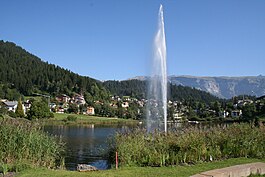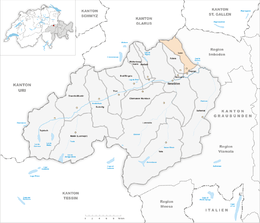Laax
| Laax/Lags | ||
|---|---|---|

Laax in August 2008
|
||
|
||
| Coordinates: 46°48′N 9°15′E / 46.800°N 9.250°ECoordinates: 46°48′N 9°15′E / 46.800°N 9.250°E | ||
| Country | Switzerland | |
| Canton | Graubünden | |
| District | Surselva | |
| Area | ||
| • Total | 31.71 km2 (12.24 sq mi) | |
| Elevation | 1,016 m (3,333 ft) | |
| Population (Dec 2015) | ||
| • Total | 1,617 | |
| • Density | 51/km2 (130/sq mi) | |
| Postal code | 7031 | |
| SFOS number | 3575 | |
| Surrounded by | Glarus Süd (GL), Falera, Flims, Ruschein, Sagogn, Schluein | |
| Website |
www SFSO statistics |
|
Laax (Romansh: Lags) is a municipality in the Surselva Region in the Swiss canton of Graubünden.
Laax is first mentioned around 1290-98 as Lags.
Laax has an area, as of 2006[update], of 31.7 km2 (12.2 sq mi). Of this area, 35.8% is used for agricultural purposes, while 30.6% is forested. Of the rest of the land, 3.6% is settled (buildings or roads) and the remainder (29.9%) is non-productive (rivers, glaciers or mountains). Before 2017, the municipality was located in the Ilanz sub-district of the Surselva district, after 2017 it was part of the Surselva Region. The municipality of Laax stretches from the village itself, to Plaun and the Vorab, in the skiing area. This is all one valley and the river eventually flows to the Rhine river. It consists of the village of Laax and the hamlets of Salums, Cons, Laax Murschetg, and Laax Dorf. The ski-lifts are in Laax Murschetg.
A small lake, Laaxersee (Lag Grond), is located in the village.
The village has views of the Signina group to the south and the Flimserstein to the north. The main facilities in the village include a swimming pool, a small supermarket, a post office and several shops, including a bakery.
Laax has a population (as of 31 December 2015) of 1,617. As of 2008[update], 16.8% of the population was made up of foreign nationals. Over the last 10 years the population has grown at a rate of 5.8%. Most of the population (as of 2000[update]) speaks German (50.3%), with Romansh being second most common (40.1%) and Portuguese being third ( 3.9%).
...
Wikipedia



